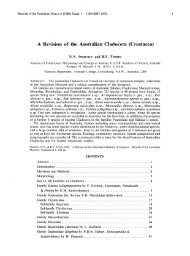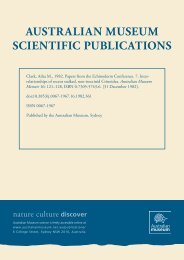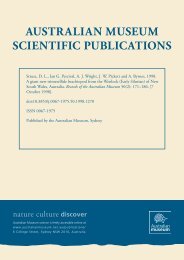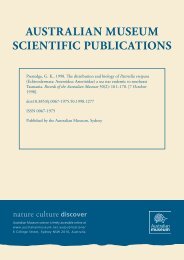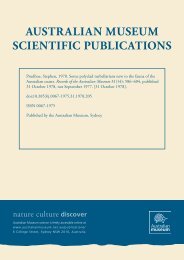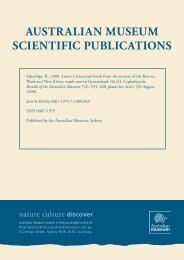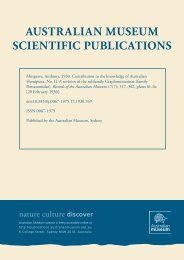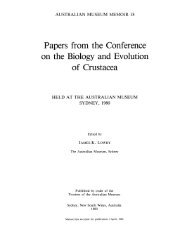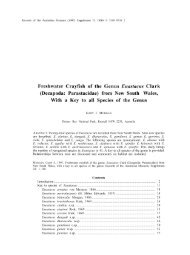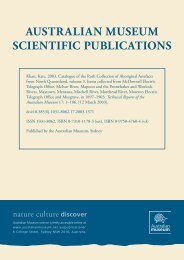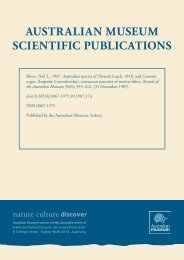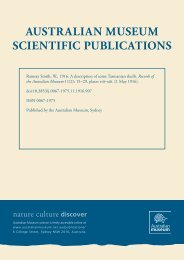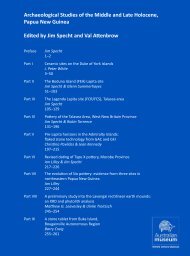View document - Australian Museum
View document - Australian Museum
View document - Australian Museum
Create successful ePaper yourself
Turn your PDF publications into a flip-book with our unique Google optimized e-Paper software.
Carved face<br />
Kalabu village, Maprik sub-province,<br />
East Sepik Province, Papua New<br />
Guinea<br />
Collected in 1964<br />
Wood, paint<br />
In Abelam society, initiations and yam<br />
ceremonies are occasions for creating<br />
various carvings. This carved face<br />
represents either the main ancestral<br />
spirit Nggwal or another spirit, and<br />
was probably part of a larger display<br />
of spirits in the haus tambaran, the<br />
central male cult house.<br />
Eharo mask<br />
Orokolo, Gulf Province,<br />
Papua New Guinea<br />
Purchased in 1920<br />
Cane, pith, bark cloth, natural<br />
pigment<br />
For the Elema people of the Gulf<br />
of Papua, the men’s ravi or longhouse<br />
was a central part of ceremonial<br />
life. Carved ancestral boards, masks,<br />
figures and drums were created and<br />
held in the longhouse for ceremonial<br />
purposes. Eharo masks are not part<br />
of sacred ceremonies; rather, they<br />
relate to humorous clan myths<br />
performed by dancers.<br />
For image requests please contact<br />
Michelle Van Doninck,<br />
Publicist <strong>Australian</strong> <strong>Museum</strong><br />
t 61 2 9320 6181 m 0421 617 019<br />
michelle.vandoninck@austmus.gov.au<br />
Kovave mask<br />
Parimono, Gulf Province,<br />
Papua New Guinea<br />
Purchased in 1915<br />
Cane, pith, bark cloth, natural<br />
pigment, synthetic pigment<br />
Initiates among the Elema people<br />
wore these masks in kovave or<br />
kaiva kuku initiation ceremonies.<br />
The masks also incorporated clan<br />
totems, such as a fish, bird or turtle.<br />
This example has a storm lamp at<br />
its top and, in addition to natural<br />
pigments, used Reckitt’s Blue laundry<br />
whitening powder.
Baba tagwa or baba kumbu mask<br />
Kamge village, Maprik sub-province,<br />
East Sepik Province, Papua New<br />
Guinea<br />
Purchased in 1980<br />
Cane, cassowary feathers, natural<br />
pigment, paint<br />
This helmet mask is worn by<br />
participants in male initiation<br />
ceremonies and is part of a full-body<br />
costume that includes a fibre or leaf<br />
skirt. The ceremony is performed<br />
on ceremonial grounds near the haus<br />
tambaran, the central male cult house.<br />
Among mask<br />
Raten village, East Sepik Province,<br />
Papua New Guinea<br />
Purchased in 1938<br />
Clay, shells, rattan, trade beads,<br />
dog teeth, pig tusks, cassowary<br />
feathers, ceramics<br />
Male initiation ceremonies commonly<br />
involve the use of masks and<br />
performance. This over-modelled mask<br />
(clay and pig fat over wood) represents<br />
an ancestor’s face and the prominent<br />
tusks give it the appearance of a pig.<br />
Traditional elements and introduced<br />
materials, such as trade ceramics, are<br />
incorporated into the face. Initiation<br />
masks were placed in the men’s<br />
ceremonial house following ritual use.<br />
For image requests please contact<br />
Michelle Van Doninck,<br />
Publicist <strong>Australian</strong> <strong>Museum</strong><br />
t 61 2 9320 6181 m 0421 617 019<br />
michelle.vandoninck@austmus.gov.au<br />
Tumbuan mask<br />
Serakum village, Maprik sub-province,<br />
East Sepik Province, Papua New<br />
Guinea<br />
Collected in 1964<br />
Cane, natural pigment<br />
For the Abelam people, many aspects<br />
of life revolve around the growing<br />
of yams and associated ceremonies<br />
and festivals. Masks are an integral<br />
part of these events. This tumbuan<br />
mask was part of a full dancing<br />
costume and was most likely used<br />
in a yam festival when collected<br />
during the <strong>Australian</strong> <strong>Museum</strong>’s<br />
1964 Sepik River expedition.
Over-modelled mask<br />
Lower Sepik, East Sepik Province,<br />
Papua New Guinea<br />
Donated in 1986<br />
Turtle shell, clay, shells, cassowary<br />
feathers, human hair<br />
‘Over-modelled’ masks (in this<br />
case, over a turtle shell) were first<br />
made following the ban on selling<br />
over-modelled skulls after the<br />
independence of PNG in 1975.<br />
They are still produced by Lower<br />
Sepik villages for the tourist market.<br />
The designs and themes of the masks<br />
reflect the taste of the contemporary<br />
carver and have little relevance<br />
to traditional mythology.<br />
Bird mask<br />
Lower Sepik, East Sepik Province,<br />
Papua New Guinea<br />
Purchased in 1994<br />
Wood<br />
In the Sepik area, ancestors could<br />
take the form of a human face, bird,<br />
insect, crocodile or other animal.<br />
This mask probably represents one<br />
of these ancestor spirits. Many of the<br />
Sepik masks collected and available<br />
today were made to meet the export<br />
demand for the region’s art. While not<br />
wholly traditional, these masks are still<br />
significant to the Sepik art story.<br />
For image requests please contact<br />
Michelle Van Doninck,<br />
Publicist <strong>Australian</strong> <strong>Museum</strong><br />
t 61 2 9320 6181 m 0421 617 019<br />
michelle.vandoninck@austmus.gov.au<br />
Tumbai mask<br />
Saparu, Yuat River, East Sepik<br />
Province, Papua New Guinea<br />
Purchased in 1938<br />
Wood, fibre, shell, natural dyes,<br />
red ochre<br />
This tumbai mask is typical of carved<br />
wooden masks from the Yuat region<br />
and is associated with a tree spirit<br />
of a particular clan. Tumbai masks<br />
were traditionally held by male<br />
dancers during ceremonies.
Ceremonial mask<br />
Northern New Ireland, Papua<br />
New Guinea<br />
Purchased in 1887<br />
Wood, shell, barkcloth, red ochre,<br />
Berliner wasch blau, black paint,<br />
aerial rootlets, coral, white lime<br />
This mask honoured the memory<br />
of dead leaders, both men and<br />
women. The characteristic facial<br />
‘bars’ have different meanings<br />
– some refer to a person’s last breath<br />
or life force. The snake attacking<br />
a flying fish is symbolic of an<br />
important person. The leader of the<br />
village during the mourning period<br />
may have used this style of mask<br />
to remove taboos restricting people’s<br />
activities at this time.<br />
Tago mask<br />
Tami Island, Morobe Province,<br />
Papua New Guinea<br />
Purchased in 1888<br />
Wood, red ochre, black paint, lime<br />
Tago masks represent the ghosts<br />
of important ancestors. Every<br />
10 to 12 years, a year-long series<br />
of ceremonies remind each clan of its<br />
ancestral connections, with two major<br />
performances celebrating the arrival<br />
and departure of the ghosts. When<br />
men wear the tago mask, a taboo is<br />
placed on all coconuts for one year<br />
and there must be peace in the village.<br />
For image requests please contact<br />
Michelle Van Doninck,<br />
Publicist <strong>Australian</strong> <strong>Museum</strong><br />
t 61 2 9320 6181 m 0421 617 019<br />
michelle.vandoninck@austmus.gov.au<br />
Mask headdress<br />
Southwest Bay, Malakula Island,<br />
North Central Vanuatu<br />
Purchased in 1984<br />
Tree fern, wood, feathers, mineral and<br />
vegetable dyes, coconut husk<br />
This headdress was worn during the<br />
final stages of the funerary rituals<br />
of a Nalawan (sacred knowledge<br />
society) member. During the journey<br />
to the world of the dead, the dead<br />
person is assisted by spirits. The<br />
wearer of this headdress becomes<br />
one with these spirits during this stage<br />
of the funerary ritual.
Kanak masks<br />
La Grande Terre, North Central<br />
New Caledonia<br />
Purchased in 1898<br />
Wood, human hair, pigeon feathers,<br />
wicker basket<br />
These impressive Kanak (indigenous<br />
people from New Caledonia) masks<br />
were most likely used during funerary<br />
ceremonies of chiefs. However,<br />
functions varied between regions<br />
and were linked with various spirits,<br />
including those of creation, the<br />
underwater world of the dead and<br />
of traditional money. It is difficult<br />
to determine the exact symbolism<br />
and function of Kanak masks as many<br />
were destroyed by early missionaries<br />
and colonial administrators and<br />
no longer used from the mid<br />
19th century.<br />
The masks are part of a costume<br />
consisting of headgear, face and<br />
clothing. The headgear is associated<br />
with the tidi or traditional hat worn<br />
by high-ranking elders, and includes<br />
human hair cut from men who<br />
had performed funerary rituals<br />
for the chief.<br />
Susu mask<br />
Pomio, East New Britain, Papua<br />
New Guinea<br />
Purchased in 1911<br />
Pith, wood, rattan, dried leaves,<br />
feathers, natural dyes, pollen<br />
Susu masks are worn by Sulka men<br />
during important ceremonies, such<br />
as initiations, marriages and funerals.<br />
The masks represent spirits and are<br />
destroyed following the ritual.<br />
This example has elongated earlobes<br />
representing initiated men and<br />
blackened teeth symbolising those<br />
of young male initiates. Masks are<br />
made in secrecy by men, out of the<br />
sight of women.<br />
For image requests please contact<br />
Michelle Van Doninck,<br />
Publicist <strong>Australian</strong> <strong>Museum</strong><br />
t 61 2 9320 6181 m 0421 617 019<br />
michelle.vandoninck@austmus.gov.au<br />
Lor mask<br />
Duke of York Islands, between<br />
New Britain and New Ireland<br />
Purchased in 1885<br />
Wood, lime, red ochre, seeds, fibres<br />
This is a rare early example of a lor<br />
mask used by members of a secret<br />
society from the Duke of York Islands.<br />
Its purpose and function is unknown;<br />
however, the face probably represents<br />
a spirit and the white colour resembles<br />
that of a dead body. The overriding<br />
expression is that of the sadness<br />
of loss.
Baining mendaska mask<br />
East New Britain, Papua New Guinea<br />
Purchased in 1978<br />
Barkcloth, bamboo, red and black<br />
natural dyes<br />
Baining people from New Britain<br />
create large barkcloth masks<br />
to represent spirits of leaves, trees,<br />
animals and insects. The masks<br />
are traditionally worn during harvest<br />
time in ceremonial dances lasting<br />
all day and night. This style of<br />
mendaska mask, made by the Uramot<br />
people, is worn during daytime<br />
ceremonies associated with female<br />
fertility, mourning and important<br />
community events.<br />
Owl head mask<br />
Notsi, Northern New Ireland,<br />
Papua New Guinea<br />
Purchased in 1887<br />
Wood, shell, pith, lime, red ochre,<br />
cambium, black paint, barkcloth<br />
Owl head masks appeared in dance<br />
performances representing the birth,<br />
life and death of the owl. Traditional<br />
rights to wear these masks for<br />
performances were probably sold<br />
from one village to the next, with the<br />
original village retaining performance<br />
rights. The masks were used in<br />
northern New Ireland from the 1830s<br />
to the 1930s.<br />
For image requests please contact<br />
Michelle Van Doninck,<br />
Publicist <strong>Australian</strong> <strong>Museum</strong><br />
t 61 2 9320 6181 m 0421 617 019<br />
michelle.vandoninck@austmus.gov.au<br />
Funerary mask<br />
Northern New Ireland,<br />
Papua New Guinea<br />
Purchased in 1887<br />
Wood, shell, hardwood spikes, rattan<br />
twine, lime, red ochre, black paint,<br />
coconut husk<br />
Men wore these masks during<br />
funerary ceremonies in Northern New<br />
Ireland. Many of the mask’s features<br />
depict death: the lime paste and<br />
spikes resemble an old man’s white<br />
hair, the shell-bead eyes bulge from<br />
the rest of the head, and the snake<br />
above them represents death.




